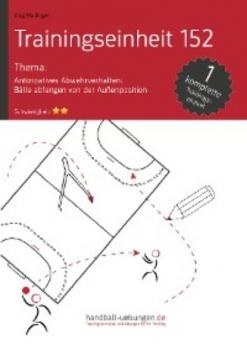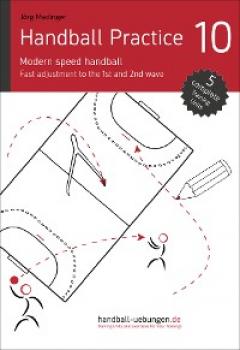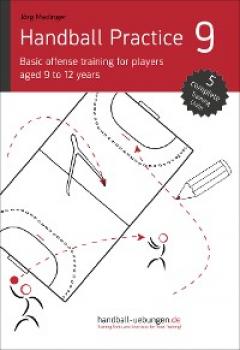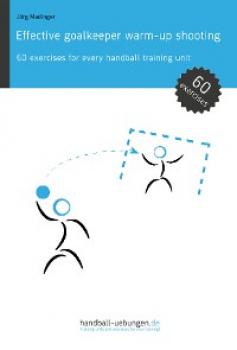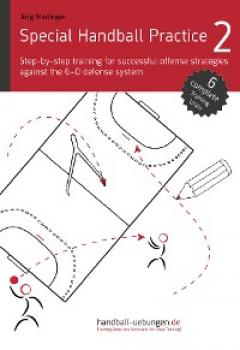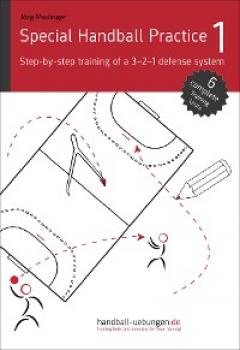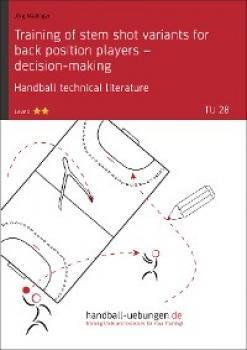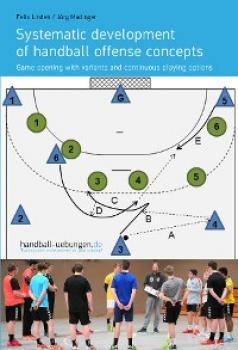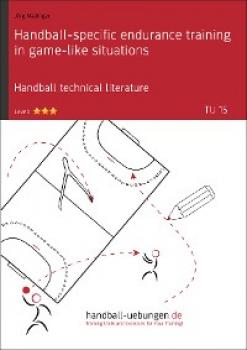Jörg Madinger
Список книг автора Jörg MadingerAntizipatives Abwehrverhalten: Bälle abfangen von der Außenposition (TE 152)
In offensiven Abwehrformationen, die vor allem auf Ballgewinne ausgerichtet sind, kommt dem antizipativen Verhalten und dem Herausfangen von Bällen eine hohe Bedeutung zu. Die vorliegende Trainingseinheit greift dieses Thema bereits beim Einlaufen auf. Nach einem kleinen Spiel wird in Ballgewöhnung und Torhüter einwerfen das richtige Timing beim Abfangen von Bällen geübt. Eine Abwehrübung kombiniert das Abwehrverhalten im 1gegen1 mit dem Herausfangen von Bällen, eine Teamübung trainiert zusätzlich das Provozieren weiter Pässe. In einer abschließenden 5gegen5 – Übung und dem Abschlussspiel soll das Geübte angewendet werden.
Insgesamt besteht die Trainingseinheit aus folgenden Schwerpunkten – Einlaufen/Dehnen (Einzelübung: 10 Minuten / Trainingsgesamtzeit: 10 Minuten) – kleines Spiel (10/20) – Ballgewöhnung (10/30) – Torhüter einwerfen (10/40) – Abwehr/individuell (15/55) – Abwehr/Team (15/70) – Abwehr/Team (10/80) – Abschlussspiel (10/90) Gesamtzeit der Trainingseinheit: 90 Minuten
Schwierigkeit: Mittlere Anforderung (geeignet ab C-Jugend bis Aktive)
Opening playing variants against various defense systems
Apart from individual technical and tactical skills, practicing different systems of cooperation may be useful to structure the offense play and force the defense to move in order to score a goal.
This textbook gives detailed step-by-step descriptions of initial actions and possible options for continuous playing against different defense systems. The playing variants aim at creating situations through team play in which the players are able to eventually shoot at the goal. If this is not possible because the defense players are very well-positioned, there are various continuous playing and subsequent shooting options explained in this book.
The first chapter initially deals with simple cooperations such as crossings, parallel piston movements, and interactions with the pivot – the essential building blocks for many of the subsequent 6-on-6 playing variants. In the other chapters, we will present examples of how to overcome passive and active defense cooperations.
A lot of the opening playing variants can be modified and used against other defense systems as well. It would be ideal, however, if the players practiced their decision-making processes in such a way that they are capable to react to changing situations and to adapt their playing creatively. This way, playing variants could be modified and extended spontaneously and lead to new shooting options over and over.
Part E deals with fast break playing options and playing options following a fast throw-off. The two last chapters focus on offense play against outnumbered defense systems, whereas the main focus will be on playing with an additional field player (goalkeeper substitution) and playing a subsequent attack in numerical superiority with a seventh field player following a time penalty against the defending team.
Included contents: Part A: Cooperation in small groups Part B: Opening playing variants and playing concepts against a 6-0 defense system Part C: Opening playing variants against a 5-1 or 3-2-1 defense system Part D: Opening playing variants against a 4-2 defense system Part E: Fast throw-off and second-wave fast break Part F: Goalkeeper substitution: Playing 7-on-6 or 6-on-6 in outnumbered situations Part G: Playing against an outnumbered defense of 5 players
Handball Practice 10 - Modern speed handball: Fast adjustment to the 1st and 2nd wave
Dear reader Thank you for choosing a book of the handball-uebungen.de training guide series.
Fast breaks are an important factor for successful handball game outcomes in modern handball. Further positive aspects include motivation of the team through quick goals in connection with demoralization of the opposing team as well as improvement of the attractiveness of the handball game itself. Quick adjustment from defense to offense play after winning the ball (or after a fast throw-off following a goal) in order to take advantage of the off-guard situation and score a goal through increased speed of play is the central objective of speed play with fast breaks.
From winning the ball and – quickly adjusting from defense to offense play – to initiating the first or subsequent second wave – and a well-structured action following the second wave – or the fast throw-off all these fast break elements are dealt with during the following five training units.
The first two units focus on fast break initiation and the improvement of passing precision and passing decisions for a first wave as well as carrying the ball forward after gaining ball possession. The third unit focuses on the decision-making process in outnumbered situations that may be created during the first or second wave, whereas the last two units practice well-structured playing against an off-guard and passively acting defense formation.
With these five training units, the collection offers ideas and incentives for practicing the individual fast break phases and provides the opportunity to implement a comprehensive concept that involves both the first and second wave and the fast throw-off.
This book contains the following training units: TU 1 – Improving passing precision when initiating the first wave The objective of this training unit is to improve running paths, passing and the decision-making process during the first wave. After a warm-up running exercise, the subsequent short game already includes quick adjustment exercises and long passes. During the ball familiarization phase and the goalkeeper warm-up shooting, the players practice playing long passes before they combine several actions with first wave initiation in a series of shots. The closing small group exercises finally focus on making passing decisions.
TU 2 – Quick adjustment to a fast break after a defense action ( ) The objective of this training unit is to practice the quick adjustment from defense play to fast break initiation. Following the warm-up phase with a coordination run exercise and the ball familiarization phase, the goalkeeper warm-up shooting combines a preparatory defense exercise and a series of shots for the goalkeeper. During the two subsequent defense exercises, the players practice quick adjustment from defense work to fast break countermovement. A 4-on-4 game and a sprint contest complete this training unit.
TU 3 – Improving speed play for fast break situations The objective of this training unit is to improve free play in fast break situations. Following warm-up and a short game, the players play long passes during the ball familiarization phase which will be further developed in the goalkeeper warm-up shooting exercise. This is followed by a series of shots requiring precise passes. Afterwards, the players practice free play in outnumbered, open situations during fast breaks. A closing game with gradually increasing complexity completes this training unit.
TU 4 – Developing a well-structured second wave by implementing long crossing moves and options for further playing The objective of this training unit is to develop a long crossing during the second wave. Following a warm-up running exercise, a short game, and a ball familiarization exercise, the players initially develop the long crossing during the goalkeeper warm-up shooting phase. In the subsequent series of shots which will be combined with a 1-on-0 fast break, the players practice the long crossing with compensation of the center back player. Defense players and the pivot are added for the two subsequent small group exercises, before the players implement the course 4-on-4 during the closing part of the training unit.
TU 5 – Step-by-step development of initial actions after a fast throw-off The objective of this training unit is to develop a simple initial action after a fast throw-off. Following warm-up and a coordination run exercise, the players practice the basics during the ball familiarization phase and the goalkeeper warm-up shooting. During the three subsequent exercises, the players further develop the running and passing paths and eventually combine them in order to create an initial action. In the closing game, the players implement what they practiced before.
Handball Practice 9 - Basic offense training for players aged 9 to 12 years
The five training units in this book focus on training of handball basic skills for young players aged 9 to 12 years. The individual training units deal with passing precision, shooting movements, dribbling technique, breaking away from man coverage, and passing feints, respectively. The players develop the individual skills methodically and step by step from basic to complex level. You may adjust the complexity of the exercises to your team’s level of performance by intensifying the individual drills.
This book contains the following training units: TU 1 – Improving passing precision during running movements The objective of this training unit is to improve the passing precision during running movements, in particular. Following warm-up consisting of combined running moves and passing variants and a short game, the players practice passing while running at full speed during the ball familiarization phase. The goalkeeper warm-up shooting and the subsequent series of shots also focus on playing passes while running at full speed. A second series of shots combines double passes on a defined running path with quick passes in direction of the goal. Finally, the players practice playing precise passes under pressure in a small group game and a closing game.
TU 2 – Developing and improving the shooting movement This training unit focuses on acquiring and improving correct shooting movements. This means shooting while standing and shooting while running, without a jump however, in order to highlight arm and body movements. Following a warm-up exercise which already involves shots, the players practice the shoulder and arm rotation for shooting and subsequently combine these moves in a passing competition. In a short game, the players implement the shooting movements in a game situation. This is followed by the goalkeeper warm-up shooting and a closing series of shots which focuses on shooting at the goal. TU 3 – Improving the dribbling technique while observing the game situation The objective of this training unit is to improve the dribbling technique focusing on simultaneous observation of the game situation. The players combine movements with dribbling already during the warm-up exercise; in a sprint contest and a short game, they practice dribbling at increased speed. Following the goalkeeper warm-up shooting, there will be a series of shots with additional coordination tasks in which the simultaneous observation of signs will be added. The subsequent small group exercise demands observation of the game situation while dribbling the ball. In a closing game, the players should implement what they practiced before.
TU 4 – Breaking away from man coverage using running feints This training unit focuses on breaking away from man coverage without a ball, by means of running feints. Following warm-up, a sprint contest with changes of direction, and a team ball variant, the players practice quick changes of direction one more time during the goalkeeper warm-up shooting exercise. Subsequently, there will be an individual offense exercise focusing on breaking away by means of running feints. The players will further elaborate this topic in two small group exercises and finally implement what they practiced before in free play.
TU 5 – Gaining positional advantage using passing feints The key topics of this training unit are passing feints and how to combine them with a breakthrough or a return pass to a teammate. Following a warm-up running exercise, the players already learn how to pass the ball cleverly in a short game; this will be further developed in the ball familiarization phase. In the goalkeeper warm-up shooting exercise, the players practice passing feints in combination with a 1-on-1 breakthrough; in the subsequent series of shots, they combine the passing feint with a return pass to their teammate. Both variants will be implemented twice in the subsequent 1-on-1, 3-on-2, and 4-on-4 games.
Effective goalkeeper warm-up shooting
Goalkeeper warm-up shooting is essential for almost every training unit. These 60 warm-up shooting exercises provide you with a variety of ideas to make the warm-up shooting challenging and diverse, both for the goalkeepers and the field players. The exercises particularly focus on improving the players’ dynamics even during the warm-up shooting.
The exercises are illustrated and described in an easy, comprehensible manner. They can be immediately integrated in every training unit. Whether you combine the exercises with additional coordination drills or use them as an introduction to the main part – various difficulty levels allow for adjustment of the warm-up shooting to each training unit and age group.
Special Handball Practice 2 - Step-by-step training of successful offense strategies against the 6-0 defense system
These training units elaborate initial actions against the 6-0 defense system as well as variable options for continued playing. The first three training units teach the tactical basics of playing against the 6-0 defense on an individual and a small-group basis. This includes the dynamic piston movement with breaking through decisions as well as the basics of crossing movements and team play with the pivot. The subsequent three training units introduce crossing of the center back with the wing player as an initial action and provide three more options for the team to overcome the defense through continued playing.
This book contains the following training units:
Basics of the piston movement This training unit focuses on developing the basics of the piston movement. Following warm-up and a coordination run, the players develop the basics of the piston movement step by step during the subsequent ball familiarization and a piston movement team exercise. The goalkeeper warm-up shooting is characterized by piston movements/counter piston movements and a subsequent shot at the goal. In a small group exercise, the players further develop the piston movement, while the team exercise focuses on training the piston movement 5-on-5. A sprint contest completes this training unit.
Basics of the crossing movement The objective of this training unit is to develop simple crossing moves. Following warm-up and a coordination run that includes reactions to changing situations, the players develop simple crossing moves during the ball familiarization exercise. In the subsequent goalkeeper warm-up shooting exercise, the crossing moves will be extended by a shot at the goal. Step by step, the players develop a crossing move with a subsequent shot from the back positions until finally, they are able to do two consecutive crossing moves. During the 6-on-6 final game, the players implement what they practiced before.
Interacting with the pivot This training unit focuses on the interaction of the back position players with the pivot. Following a warm-up game and a ball familiarization exercise, the players practice the interaction with the pivot during the goalkeeper warm-up shooting. In the two subsequent exercises, the players further develop and practice the interaction step by step. A sprint contest completes this training unit. Long crossing of the center back and the wing player as initial action – Part 1 This training unit focuses on the development of a simple initial action with crossing of the center back and the wing player. Following a short warm-up game, the players gradually develop the initial action during the ball familiarization phase. After the goalkeeper warm-up shooting, there are two team exercises during which the players practice the running moves of the initial action as well as several options for continued playing and variants. A closing game completes this training unit.
Long crossing of the center back and the wing player as initial action – Part 2 In this training unit, the players gradually further develop the initial action of the previous training unit and practice further possible solutions. Following a short warm-up game, the players develop the running paths during the ball familiarization phase. The goalkeeper warm-up shooting includes a simple crossing move with a subsequent shot at the goal. During two team exercises, the players practice the different playing options that are to be implemented in the subsequent closing game.
Long crossing of the center back and the wing player as initial action – Part 3 In this training unit, the players take up the initial action of the two previous training units and practice further possible solutions. Following warm-up with a coordination run, the players develop an additional crossing move during the ball familiarization exercise and the goalkeeper warm-up shooting. The players further develop this step by step in a series of shots. In a team exercise, the players combine the new crossing move with the initial action they practiced before and eventually implement both in a 6-on-6 game. A sprint contest completes this training unit.
Special Handball Practice 1 - Step-by-step training of a 3-2-1 defense system
The 3-2-1 defense system is an excellent strategy to put the attacking players under pressure in their initial actions. This often results in quick turnovers and fast breaks. However, a good basic fitness as well as a thorough 1-on-1 defense training are prerequisite for this. To make your youth training comprehensive, include practicing the 3-2-1 defense system as a mandatory element. As in each volume of the handball-uebungen.de series, this book has its focus on practical exercises which can be integrated in each handball training unit. Get inspired, learn how to develop a 3-2-1 defense system, and don’t forget to be creative on your own! A short theoretical introduction to the general training schedule will help you to integrate training units into your own annual schedule.
Training of stem shot variants for back position players – decision-making TU (28)
This training unit focuses on improving stem shots. Following warm-up, the players repeat different stem shot variants during the ball familiarization phase. After a shooting competition and the goalkeeper warm-up shooting, the players practice these shooting variants by playing against an inactive defense player before they practice making stem shot decisions by playing against a more active defense player. In a series of shots and another individual offense exercise, the players subsequently practice the different stem shot variants in various situations similar to the real game. Finally, they implement the shooting variants in a 3-on-3 game.
The training unit consists of the following key exercises: – Warm-up/Stretching (individual exercise: 10 minutes/total time: 10 minutes) – Ball familiarization (15/25) – Shooting competitions (10/35) – Goalkeeper warm-up shooting (10/45) – Offense/Individual (15/60) – Offense/Series of shots (10/70) – Offense/Individual (10/80) – Offense/Small groups (10/90) Training unit total time: 90 minutes
Training unit requirements: Intermediate requirement (youth teams under 15 years of age and adult teams)
Systematic development of handball offense concepts
This is the second time Felix Linden (A-License and certified DHB young talents’ coach for competitive areas) gives insights into his understanding of diverse and focused handball training in the book series of handball-uebungen.de. Based on crossing of the center back and the pivot (circle) – which is part of almost every team’s repertoire in various forms – Felix Linden explains how you can create different game situations by using simple extensions and hence overcome defense systems with many variants. The individual training units deal with essential elements such as pulling apart a 6-0 defense system, authentic piston movements, pulling out a defense player, different shooting options, and decision-making. All training units focus on decision-making processes in particular. The training units comprise the standard playing structures with continuous playing options on both sides, variants with a second pivot and position switching as well as a variant for outnumbered game situations.
Within the last few years, several counteractive defense measures have been developed in order to interrupt the back position/pivot circle. Consequently, it is important to practice different situations with regard to the back position/pivot circle. The last chapter shows various defense measures and provides an idea of which variants should be played in each situation.
This book contains the following training units: – Game concept – Crossing of the center back and the pivot – Part 1 – Game concept – Crossing of the center back and the pivot – Part 2 – Game concept – Crossing of the center back and the pivot plus second pivot from the wing position – Game concept – Crossing of the center back and the pivot plus second pivot from the back position – Crossing of the center back and the pivot in outnumbered situations
Handball-specific endurance training in game-like situations (TU 15)
This training unit contains a playful, handball-specific endurance unit. Each exercise is characterized by a high running intensity and is directly related to the handball game. After warm-up and ball familiarization as well as goalkeeper warm-up shooting, an endurance course is done. In this, two players have to accomplish a task as opponents. Which team is the first to score eight times? A sprint contest completes this intense training unit.
The training unit consists of the following key exercises: – Warm-up/Stretching (individual exercise: 10 minutes/total time: 10 minutes) – Ball familiarization (10/20) – Goalkeeper warm-up shooting (10/30) – Endurance course (50/80) – Sprint contest (10/90) Training unit total time: 90 minutes
Difficulty level: High level (youth teams under 17 years of age and adult teams)
